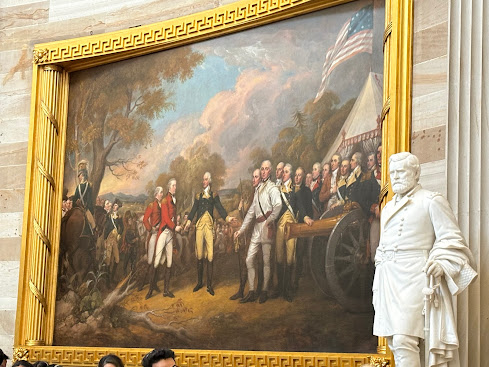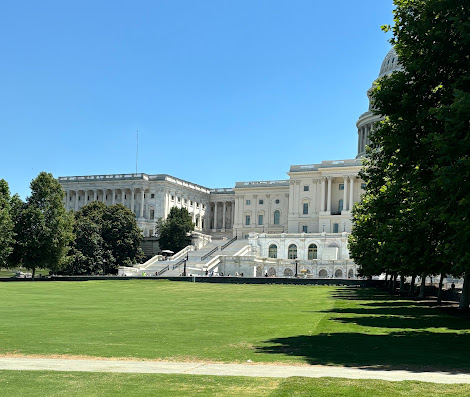Although we'd been to the U.S. Capitol in the past, we'd never taken a tour so we decided it was time to do so.
The United States Capitol is a symbol of the American People and our government and the meeting place of the U.S. Congress. The Capitol is a working office building, but it is also the place where visitors from around the country and the world come to learn about American democracy. Each year, it is visited by an estimated 3-5 million people from around the world.
Construction of the Capitol began in 1793. In November 1800, Congress, along with the Library of Congress and the Supreme Court, moved into the newly completed north wing. The south wing was completed in 1807, but in 1814, the British burned the Capitol during the War of 1812. What is now the center portion of the Capitol was completed in 1826.
Since we were last here, there is now a Visitor Center downstairs which is the meeting spot for tours.
The place was packed and there were several school groups. We got in our group and off we went.
The plaster mold for the Statue of Freedom, which is the bronze figure on the top of the dome, is on permanent display in the Visitor Center. The statue depicts a female figure bearing a military helmet and holding a sheathed sword in her right hand and a laurel wreath and shield in her left. This statue has crowned the Capitol dome since 1863.
In 1993, after being in place nearly 130 years, the statue was brought down from its pedestal by helicopter for restoration. The work was needed because of extensive pitting and corrosion on the surface of the bronze and because of a crack and rusting on the cast-iron pedestal.
Restoration of the statue and the pedestal was completed in approximately four months. The Statue of Freedom was returned to its pedestal by helicopter and since then, every 2-3 years the statue undergoes two weeks of cleaning and recoating as necessary.
Also on display is a Senate chamber desk.
Made by T. Constantine & Co., 1819, U.S. Senate Collection (Reproduction)
The 100 desks used daily on the floor of the Senate Chamber are among the most iconic and recognizable symbols of the Senate. The earliest 48 desks date back to 1819 when there were only 22 states. As senators arrived from new states, the Senate acquired additional desks of similar designs for their use in the Chamber.
We went into Statuary Hall, a chamber devoted to sculptures of prominent Americans. It is located immediately south of the Rotunda and was the meeting place of the U.S. House of Representatives for nearly 50 years (1807-1857) and after a few years of disuse it was repurposed as a statuary hall in 1864. This was when it was established as the National Statuary Hall Collection when Congress invited each state to contribute two statues of prominent citizens for permanent display. By 1933, the collection had outgrown this single room, and a number of statues were placed elsewhere within the Capitol.
We saw a few statues as we made our way into the hall.
Sakakawea was a Lemhi Shosone woman who, in her teens, helped the Lewis and Clark Expedition in achieving their chartered mission objectives by exploring the Louisiana Territory. She traveled with the expedition thousands of miles from North Dakota to the Pacific Ocean, helping to establish cultural contacts with Native American people and contributing to the expedition's knowledge of natural history in different regions.
Kamehameha I was the conqueror and first ruler of the Kingdom of Hawaii.
The statue of Helen Keller (1880-1968), one of Alabama's entries, was an author, disability rights advocate, political activist and lecturer. As most know, she lost her sight and her hearing after an illness when she was 19 months old. After an education at both specialist and mainstream schools, she attended Radcliffe College of Harvard University and became the first deafblind person in the United States to earn a Bachelor of Arts degree.
And then it was into the hall.
Many important events took place in this Chamber while it served as the Hall of the House. It was in this room in 1824 that the Marquis de Lafayette became the first foreign citizen to address Congress. Presidents James Madison, James Monroe, John Quincy Adams, Andrew Jackson, and Millard Fillmore were inaugurated here. In 1825, John Quincy Adams was elected president by the House of Representatives, none of the candidates having secured a majority of electoral votes. Following his presidency, Adams served as a Member in the Hall for 17 years. He collapsed at this desk from a stroke on February 21, 1848, and died two days later in the adjoining office, at the time, of the Speaker of the House.
Three people have lain in state in the National Statuary Hall: Elijah Cummings (Maryland Congressman, 2019), Ruth Bader Ginsburg (Supreme Court Justice, 2020), and Don Young (Alaska Congressman, 2022).
John "Jack" Swigert Jr. (1931-1982) was a NASA astronaut, test pilot, mechanical engineer, aerospace engineer, U.S. Air Force pilot, and politician. He was the command module pilot of Apollo 13 in 1970 and became one of 24 astronauts who flew to the Moon. His statue is one of Colorado's entries.
From Massachusetts, Samuel Adams (1722-1803), a founding father of the country. He was a politician in colonial Massachusetts, a leader of the movement that became the American Revolution, a signer of the Declaration of Independence and other founding documents. He was a second cousin to his fellow founding father, President John Adams.
As we moved out of Statuary Hall, we came upon the office of the Speaker of the House. It was amazing the number of tourists that were milling in the area, although it was a weekend so not many, if any, congressional members around.
The rotunda is 96 feet in diameter, rises 48 feet to the top of its original walls and 180 feet 3 inches to the canopy of the dome. The space is a national showcase of art, and includes numerous paintings and sculptures. It is used for ceremonial or public events authorized by concurrent resolution of both houses of congress, including the lying in state of honored dead. During the Civil War, the rotunda was used as a military hospital for Union soldiers.
Some examples of the art work in the rotunda.
Declaration of Independence by John Trumbull. Commissioned in 1817, purchased in 1819, placed in 1826. The members who drafted the Declaration of Independence (John Adams, Roger Sherman, Robert R. Livingston, Benjamin Franklin, and Thomas Jefferson) present the declaration to the Second Continental Congress and President John Hancock on June 28, 1776 at Independence Hall in Philadelphia. A reproduction appears on the U.S. two dollar bill.
General George Washington Resigning His Commission by John Trumbull. Commissioned in 1817, placed in 1824. George Washington addresses Congress to resign his commission as commander-in-chief of the Continental Army on December 23, 1783. Future presidents Thomas Jefferson, James Monroe and James Madison are also shown in the painting. Martha Washington and her three grandchildren are shown watching from the gallery section (balcony area at right), although they were not present at Washington's resignation.
Surrender of General Burgoyne by John Trumbull. Commissioned 1817, purchased 1822, placed 1826. British soldiers under General John Burgoyne surrender after the American victory at the Battle of Saratoga in 1777.
There is a crypt that was intended as the burial place for George Washington. Originally the crypt had an open ceiling into the rotunda and visitors can still see the holes in the stone circle that marked the rim of the open space. Underneath the floor of the crypt lies a tomb but after a lengthy battle with his estate and the commonwealth of Virginia, the plans for him to be buried there were abandoned.
The dome is breathtaking.
The Apotheosis of Washington is a large mural by Greek-Italian Constantino Brumidi, visible in the center of the dome. This depicts George Washington sitting exalted amongst the heavens. It is suspended 180 feet above the rotunda floor and covers and area of 4,664 square feet.
The Frieze of American History is painted to appear as a carved stone depicting 19 scenes from American History. The "frieze" occupies a band immediately below the 36 windows. Brumidi designed the frieze and prepared a sketch in 1859 but did not begin painting until 1878. He painted seven and a half scenes. While working on William Penn and the Indians, he fell off the scaffolding and held on to a rail for 15 minutes until he was rescued. He died a few months later in 1880. After his death, Flippo Costaggini was commissioned to complete the eight and a half remaining scenes in Brumidi's sketches. He finished in 1889 and left a 31-foot gap due to an error in the original design. In 1951, Allyn Cox completed the frieze.
American Army Entering the City of Mexico
Our tour was complete and we went downstairs to the cafeteria to get something to drink. We thought these desserts were creative - no, we didn't get any.
As we left the area we took a look back at the western front of the Capitol.
Since the 1981 inauguration of Ronald Reagan, the ceremony has been held at the west front facing the National Mall with its iconic Washington Monument and distant Lincoln Memorial. From 1829 through 1977, most swearing-in ceremonies had taken place on a platform over the steps at the Capitol's east portico. They have also been held inside the old Senate Chamber, the chamber of the House of Representatives, and the Capitol rotunda. The most recent regularly scheduled inauguration not to take place at the Capitol was the fourth inauguration of FDR in 1945, which was held at the White House.
So much more yet to see.....























Thanks for the tour!
ReplyDeleteThanks for coming along :-)
Delete